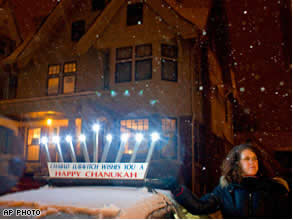
| WORLD MAP |
| Contact Information:
Call: (917) 826-3368 |
| Also featured in: | ||||
Menorah parades mark Festival of Light “I feel very proud when I have it on,” Elizabeth Crawford says of the menorah mounted atop her car for a parade in Milwaukee.
|
||||
Hanukkah takes to the streets MILWAUKEE – For some, it’s a matter of pride. For others, it’s about spreading the light of the season. Whatever the motivation, thousands of Jews around the world are taking part in menorah parades this Hanukkah, a twist on the holiday that’s been gaining popularity thanks in part to promotion of the idea by the international Chabad Lubavitch group. The concept is simple: Participants mount large, metal menorahs on cars and drive through their cities convoy-style sometime during the eight-day holiday known as the Festival of Light. This year, the Chabad Lubavitch estimates 100 cities – including Moscow, Sydney and Los Angeles – will hold parades. Some 10,000 Jews are expected to take part. Elizabeth Crawford said such events raise awareness of Judaism and give Jews pride during the holiday season, which can be a bit Christmas-heavy. The 46-year-old caterer has put a roughly 21/2-foot menorah on her silver Honda Civic for Chabad’s parade in Milwaukee this Sunday. Now in its third year, the parade is expected to have about 60 cars start in the city’s downtown and end up in the northern suburbs for a public menorah lighting. “I feel very proud when I have it on and during the week when I drive around and see other people having it on,” Crawford said. “I’m filled with pride to be part of a group of people that are not too self-conscious to show their Jewishness proudly in public.” The first menorah parade was in 1977 in New York, said Rabbi Zalman Shmotkin, director of www.chabad.org, the Chabad Lubavitch’s Web site. Since then it’s spread to dozens of cities around the globe. The Lubavitch movement is considered a major force in Judaism, with a religious focus on prayer and scholarship, and outreach to less observant Jews. In conjunction with its 3,300 centers around the world, Lubavitch holds public menorah lighting ceremonies, and plans to hand out millions of kits this year that include menorahs, candles, a guide to celebrating Hanukkah and background on its meaning. Its Hanukkah Web site – www.hanukkah.org – gets some 150,000 questions each year around the holiday, such as, “What’s the correct way to spell Hanukkah?” (Either “Chanukah” or “Hanukkah” is fine, because it all depends on translating from Hebrew.) Hanukkah, which this year began Tuesday evening, commemorates religious freedom and the successful fight against oppression. It also celebrates how a one-day supply of oil that the Jews found when recapturing the Temple in Jerusalem from Syrian-Greek occupiers miraculously lasted for eight days. Rabbi Shmotkin said the holiday has always been publicly celebrated, and the original teaching was to put the menorah in a place where people can see it, such as a window or a doorway. “Nowadays with modern technology, communication and transportation innovation, it’s possible to publicize the holiday even more,” he said. “Lighting up the streets with the message of religious freedom is entirely in keeping with American ideals, and speaks also to our responsibility of constantly bettering ourselves and transforming the world around us.” It’s also fun. Deborah Raichman, a Houston mother, said her young son, his cousins and friends crowd into the family’s sport utility vehicle for the parades and shout “Happy Hanukkah” out the windows. “They get so excited because here it’s a statement that we are proud. That it’s Hanukkah. It’s our day, too, and we’re happy to be in America where there is room for everybody,” she said. “It’s not just Christmas. It’s also our day.” The car menorahs have light bulbs that are added for each night of Hanukkah. They plug into a car’s electrical outlet and are strapped onto the roof. They cost about $225, although many Chabads allow drivers to use them for a small donation. Parades range from trails of cars in Houston and Milwaukee to lines of firetrucks and emergency vehicles, like the upcoming parade in the Maryland suburbs of Washington, D.C. Lenny Chornock, deputy fire chief in Rockville, Md., spent years participating in Christmas parades. Three years ago he started a Hanukkah parade. This year three firetrucks – one with a 3-foot-tall menorah – and other rescue vehicles will go to six stops as a DJ blasts Hanukkah music. Participants will hand out bags of chocolate coins called Hanukkah gelt, other candy and DVDs about their faith. The first year they blocked off an entire street and it became emotional, said the 50-year-old Chornock. “It was like for the first time that I’ve ever been in a situation except for in Israel where the entire street was doing a Jewish activity,” he said. “It was a pretty wild experience. My father was there. He started crying.” Copyright 2007 Associated Press. All rights reserved. |
||||
